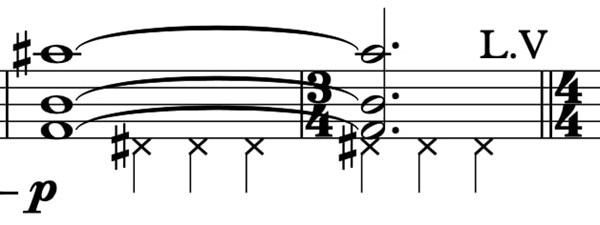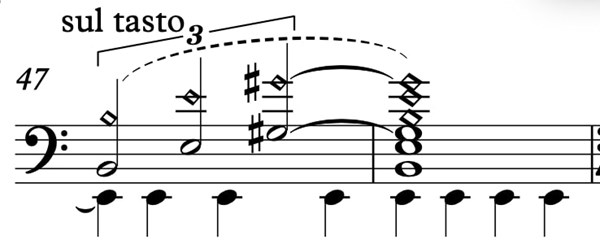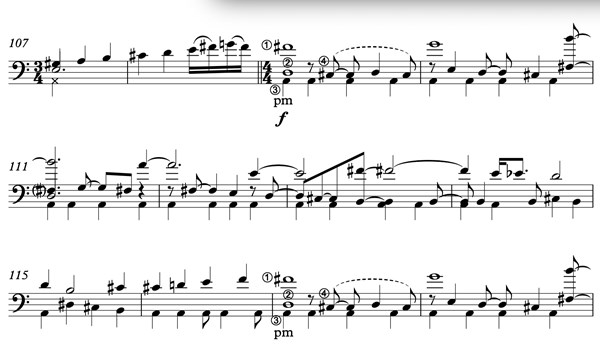'Shrinking Steps' - An exercise in technical and musical acceptance
'Shrinking Steps - Nate Chivers, for 4-string electric bass
Nate Chivers is a contemporary music composer studying for his PhD in composition at the Royal Northern College of Music, UK. We recently discussed the opportunity for me to record one of his pieces 'Shrinking Steps' a contemporary solo bass piece and style of performance that is quite alien to me. For Nate, as an established contemporary composer it would be interesting to understand how his piece would be interpreted by an instrumentalist unfamiliar with the techniques and approaches utilised within.
The Style of the Piece
Nate composes with melody and texture in mind which immediately are both concepts not usually associated with the electric bass guitar. We would more likely attribute rhythm and harmony as the most important attributes of bass guitar playing. This disparate focus however, is interesting and along similar lines to my own work and practice, albeit in a different vein.
"The piece was written with the audio image of a clock in mind. Ticking and tocking in the middle of the night while thoughts float through ones mind." - Nate Chivers
Shrinking Steps has an ethereal feel, it juxtaposes clarity and nebulousness through multi-voice and multi-texture techniques utilised both separately and simultaneously. I realised quite early on that one needs poise and delicacy to execute this piece well. In Nate's own words: "My music is oddly challenging, none of it is like Billy Sheehan or Victor Wooten where everything is so fast and athletic, its more like a gymnast on a balance beam."
Moments of Interest and Challenge
As I am unfamiliar with this approach to electric bass guitar performance in many ways, there were a number of particularly interesting moments that created individual practice challenges and technical problems for me to solve. The following are examples of these which can been seen in the PDF notation and heard in the MP3.
Bar 16/17 (1m:16s) Open String Muted Rake
I wasn't sure if these needed to be at pitch or 'dead notes'. That first I couldn't understand the purpose of these music rakes, they sounded odd and distracting to my ears until I read the instruction that these notes need to sound with very little indication of pitch, this coupled with the general instruction that the piece is representing the "audio image of a clock", this sound had purpose when thought of almost like a ratchet mechanism.
Bar 20 (1m:30s)- Melody + 4ths in a low cluster with added B.
I found this difficult and a bit overwhelming as a sound, (4ths first, but more so with the B added) as a bassist I have been trained to avoid clusters in the low register that inhabit far past what is commonly accepted as the lower interval limit, however here they were a requirement. At first I disliked the sound as a lack of clarity in root was somewhat disguised, my ears are accustomed to creating and providing clarity in the low register but after a while my experience of it altered and I grew to view and feel this attribute as an sound texture in itself, devoid of functional coherence. I had to put aside thoughts of: "this isn't right, I can't hear the individual notes" to experiencing it as a compound cluster designed to rumble and clash as the frequencies bounce off of each other disguising any obvious harmonic meaning. This was the first moment realising this piece would just be technically challenging but mentally challenging also.
Bar 25 (1m:52s)
The bringing of consonance at bar 25- felt like a lovely release from this but it became the first technical challenge to overcome, performing 3 textures to sustain in quick succession: double stop of a major 6th, a harmonic, followed by muted root note. This was difficult and required a number of considerations to execute: 1) Each attribute required performance independent of the other technique so as to not interfere with each other; 2) Left hand technique was required to allow this to happen meaning adaption from typical hand and finger positioning; 3) Right had technique was required to mute a single string but allow others to be sounding freely, once again diverging from typical right hand technique where all strings are usually muted or not in order to achieve consistency of tone through a bass line. This became tricker to achieve in bar 27 with the addition of slight melodic movement in the fretted double stops.
There was exploration in the initial learning of this part of the piece to discover the best approach to perform it. Firstly, harmonics were discovered in various places on the finger board followed by the attempt to fit the double stop around this, all with the caveat that the muted D could only be played on the open string, 5th fret A string or 10th fret E string. I explored different permutations of theses, realising that some wouldn't allow the harmonic to ring true, or the double stop to be playable, etc. At a point, as with many experiences learning this piece, I believed the problem to be physically unplayable and that a sacrifice would be required musically in order to perform this moment. But I eventually discovered the solution through questioning and keeping in mind the required parameters and requirements, this approach was adopted and continued to solve upcoming problems of technique and performance application.
Bar 37 (2m:49s)
In discussion with Nate this moment was interesting. I had particular difficulty performing this 6 fret span for an F# (2nd fret E string) to C# (6th fret G string), the span itself with my typical left hand placement would have been possible but difficulty increased with the requirement to to keep the open A and D strings ringing. For Nate this was not even a consideration as he owns a larger hand span than myself, but I found the stretch indeed difficult.
Bar 47 (3m:27s)
The artificial harmonics required in this bar along with the root note pulse was another interesting technical problem to solve. In typical musical contexts the bass guitar would not be required to play artificial harmonics and especially not with other notes underneath and again was a technique I was unaccustomed to. The solution turned out to be the same as how Nate would have played it from his guitar technique background.
Bar 63 - 71 (4m:30s)
Another instance of how hand size plays into the experience of playing the notated material, Nate stated keeps his parts deliberately vague in places as he is interested in how others approach playing particular passages. I could find no solution to performing this particular 4 bars other than utilising right hand tapping for the melody. Again for Nate this isn't an issue due to the larger dimension of hand span. This brings up an interesting question to explore the extent to which hand span size can dictate certain musical and technical approaches on the bass guitar.
In my first demo recording of this piece for Nate, he felt I got a bit lost, not technically but not not understanding how the section 'fits'. It is interesting that Nate picked up on this as it certainly was the case. The off-set rhythm of the crotchet triplets was difficult technically and musically. I attempted to play it as precisely as possible but this wasn't they objective. On discussion, Nate explained how this section is supposed to feel like having the carpet pulled out from underneath you ... breaking it down in order to build it back up. "
Using right hand tapping seemed to be a good solution. Typically, right hand tapping is used in a distinctly rhythmic fashion on the bass guitar (in the few instances where its an appropriate technique). Here the technique was used to solve the disconnected multi-voice problem I was faced with, in order to help create a freer flowing melody. In the above diagram, the A in bar 64 was sustained further to help with this effect.
Bar 84/85 (5m:54s)
This was one of my favourite moments in the piece. The close contrapuntal nature of the harmony as double stops and the chromatic nature of the harmony was very satisfying, especially as a contrast from the consonance and diatonicism that has been stated before (such as bar 73-75).
Bar 109 (7m:37s)
This section provided perhaps the trickiest and most complex technical problems to solve and was certainly the section that took the most amount of practice to become comfortable with. Here there are 3-4 voices working independently of each other: the muted, rhythmic bass drone on the open A-string; the ringing open-D string; the moving middle voice on the lower E-string, as a challenge in and of itself to perform a higher pitch than the muted drone but on a lower string; and finally the top melodic voice.
I first began to work slowly and sequentially, attempting to play notes chronologically as I usually would when encountering challenging sequence, but I soon encountered the technical issues that would need to be solved first. At this early stage they existed as a barrier to progressing. Instead chose to break down this particular puzzle into sections and solve the problems independently, before reconfiguring everything into its context.
Firstly, how to play the muted A drone on an open string whilst allowing other strings to clearly ring. Secondly, where the middle voices would need to be executed on the E-string and combining this with the muted A string. This in itself was confusing and took some time. Reading notes that are higher in pitch but playing them geographically lower on the bass was surprisingly difficult. Thirdly, I brought in the open D in the first bar, although this didn't end up being a main focus due to is single bar duration and feels its notated direction to last the entire bar became an interpretation to joining the middle voice movement. Finally, adding the top melodic voice. This created a final problem to solve however, as notes would now need to be fretted on the G-string and the E-string simultaneously and require a slight rethink of left hand positioning, especially from bar 111. Thus the process of breaking down the problem voice by voice began again but with the current knowledge as a starting point. Once everything could physically work chronological practice began.
General Thoughts
There is similarity I both Nate's and my work. We both recognise the potential of the electric bass guitar to create unique sonic landscapes outside of its traditional and typical instrumental and ensemble role. It's interesting that we are approaching this from very disparate angles. For Nate this piece is intended as a solo performance- a through composed comprehensive arrangement; in my work techniques and approaches are managed compounded using technology or they are more overtly 'borrowed' from other instruments melodic vocabulary or ensemble identity.
I quickly realised that keeping an open mind to this piece would be important, I had to remove my bass player's hat and think about what the music represented. There was nothing 'typical' about this piece which was disconcerting, but I knew there was a great deal to be learnt from attempting it.
My experience of practicing Shrinking Steps was a rollercoaster journey in itself. The piece very quickly became frustrating in the early days of practice as I realised how challenged I was facing so many new and unknown technical problems to solve and musical textures on the bass guitar to become familiar with, I felt I was floundering for a long time before familiarity and comfort began to settle in. But it did eventually. Moment of clarity, or 'Ah-ha' moments were plentiful which led to renewed enthusiasm before being cast down by the next problem. It was difficult not to take the multitudes of technical difficulties as personal 'failures' but to remember that there is little about this piece that a trained electric bass player would be used to performing. The experience of the absolute necessity to learn 'new' techniques reminded me of the early days of my bass playing career, and more painfully when studying at conservatoire and needing to completely re-learn my fundamental technique. I was required to accept my own limitations and work from the place of the beginner once again.
Overall though, the piece was a hugely satisfying experience to work on and develop. I have gained a number of new ways of thinking about the bass both musically and technically. The approaches to texture and melody will certainly be ideas I will develop further in my own work. Studying this piece has allowed me to begin exploring additional multi-voiced vertical approaches on the bass guitar as a method for creating interesting textures with the instrument.
Posted In: Reflections on Practice
Tagged: Bass Solo, Composition, Practice, PaR, Practice as Research
← Back to Recent Posts








